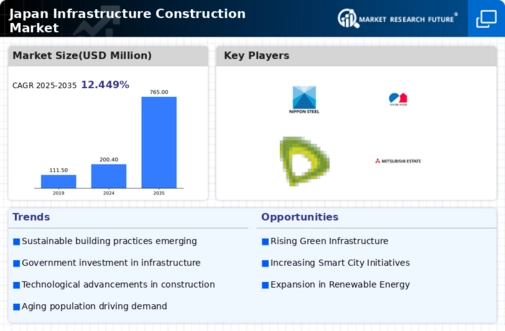The infrastructure construction market in Japan is characterized by a competitive landscape that is both dynamic and multifaceted. Key growth drivers include government investments in public infrastructure, urban development projects, and a growing emphasis on sustainability. Major players such as Obayashi Corporation (Japan), Shimizu Corporation (Japan), and Taisei Corporation (Japan) are strategically positioned to leverage these trends. Obayashi Corporation (Japan) focuses on innovation and digital transformation, while Shimizu Corporation (Japan) emphasizes sustainable construction practices. Taisei Corporation (Japan) is actively pursuing regional expansion, particularly in Southeast Asia, which collectively shapes a competitive environment that is increasingly focused on technological advancement and sustainability.
The market structure appears moderately fragmented, with several key players exerting considerable influence. Business tactics such as localizing manufacturing and optimizing supply chains are prevalent among these companies. This approach not only enhances operational efficiency but also allows for greater responsiveness to local market demands. The collective influence of these major players fosters a competitive atmosphere where innovation and strategic partnerships are paramount.
In November 2025, Shimizu Corporation (Japan) announced a partnership with a leading technology firm to develop AI-driven construction management tools. This strategic move is likely to enhance project efficiency and reduce costs, positioning Shimizu Corporation (Japan) as a frontrunner in the digital transformation of the construction sector. The integration of AI into their operations may also lead to improved decision-making processes and resource allocation.
In October 2025, Taisei Corporation (Japan) secured a major contract for the construction of a new urban transit system in Tokyo. This project not only underscores Taisei Corporation's (Japan) commitment to regional expansion but also highlights its capability to manage large-scale infrastructure projects. The successful execution of this contract could bolster the company's reputation and open doors for future opportunities in urban development.
In September 2025, Obayashi Corporation (Japan) launched a new initiative aimed at reducing carbon emissions in construction processes. This initiative aligns with global sustainability trends and positions the company as a leader in environmentally responsible construction practices. By prioritizing sustainability, Obayashi Corporation (Japan) may attract clients who are increasingly focused on green building practices.
As of December 2025, current competitive trends in the infrastructure construction market are heavily influenced by digitalization, sustainability, and AI integration. Strategic alliances are becoming more common, as companies seek to enhance their technological capabilities and market reach. The competitive differentiation is likely to evolve from traditional price-based competition to a focus on innovation, technology, and supply chain reliability. This shift suggests that companies that invest in advanced technologies and sustainable practices will be better positioned to thrive in the future.















Leave a Comment